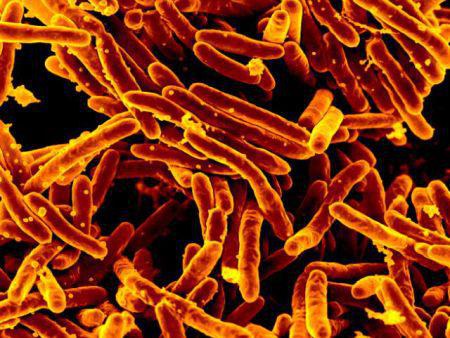Coming closer to the menu of tuberculosis

Jülich, January 14, 2020 – Certain white blood cells, the macrophages, eat foreign proteins and microorganisms as part of the innate immune defence. But unlike other pathogens, eaten tuberculosis bacteria can survive inside the macrophages. Various aspects play a role here. Scientists at Research Centre Jülich and the University of Surrey in Great Britain have now determined the menu of the eaten pathogens. The researchers have also identified a promising target for new drugs.
According to the World Health Organization (WHO), 1.6 million people died of tuberculosis in 2018. Caused mostly by the pathogen
Mycobacterium tuberculosis
, tuberculosis ranks first in the statistics of fatal infectious diseases. The mystery of how the pathogen can survive and multiply in human macrophages is driving many researchers worldwide. Scientists at the University of Surrey in Guildford and Forschungszentrum Jülich have now investigated a special aspect of this mystery: Where does the vital nitrogen come that allows the bacteria to survive inside the macrophages?
The research was reported in the journal "Cell Reports". According to these findings, the pathogen takes up various amino acids from its hosting macrophage. The most important nitrogen source is glutamine, but also glutamate, aspartate, alanine, glycine and valine. In contrast, the bacterium has no access to the serine of the macrophage - a nutrient it also needs for survival, but has to be produce by itself.
By this, the scientists have discovered a point of attack and, thus, the development of new drugs: substances that inhibit the bacteria's own production of serine should be able to effectively combat the tuberculosis pathogen. Specifically, such a substance could, for example, block phosphoserine transaminase, an enzyme on which the pathogen depends for the production of serine.
The scientists gained these findings by analysing the nitrogen metabolism of the tuberculosis bacterium in detail. The reason for this: If the pathogen wants to produce the vital serine itself, it needs the "building blocks" for this - in particular nitrogen, which it obtains from the available amino acids of the macrophage. The British-German research team developed a novel method for their analysis. It cleverly combines experimental studies and computer simulations. During the experiments, the scientists fed the infected macrophages with various amino acids. In one of them, they replaced normal-weight nitrogen atoms - nitrogen isotopes with the mass number 14 (
14
N) - with heavier nitrogen atoms - mass number 15 (
15
N).
Using mass spectrometry, they determined in which proportions and in which metabolic products of the bacterium the
15
N isotopes are found. These experimental results of the British researchers formed the basis for the computer simulations at Jülich. "We have developed a computer model of nitrogen metabolism that determines the pathways of the amino acids that are taken up by the pathogen and describes the activity of the metabolism," explains Katharina Nöh from the Jülich Institute of Bio- and Geosciences. She heads the "Modelling of biochemical networks and cells" team, which has already made a major contribution to understanding the carbon metabolism of the tuberculosis pathogen in recent years.
Original publication:

Intracellular Mycobacterium tuberculosis Exploits Multiple Host Nitrogen Sources during Growth in Human Macrophages.
Further informationen:
Institut für Bio- und Geotechnologie, Bereich Biotechnologie (IBG-1)
Contact:
Dr. Katharina Nöh
Institut für Bio- und Geotechnologie, Bereich Biotechnologie (IBG-1)
Forschungszentrum Jülich
Tel.: 02461 61-9294
E-Mail: k.noeh@fz-juelich.de
Press contact:
Tobias Schlößer
Unternehmenskommunikation
Tel.: 02461 61-4771
E-Mail: t.schloesser@fz-juelich.de
Erhard Zeiss
Unternehmenskommunikation
Tel.: 02461 61-1841
E-Mail: e.zeiss@fz-juelich.de
